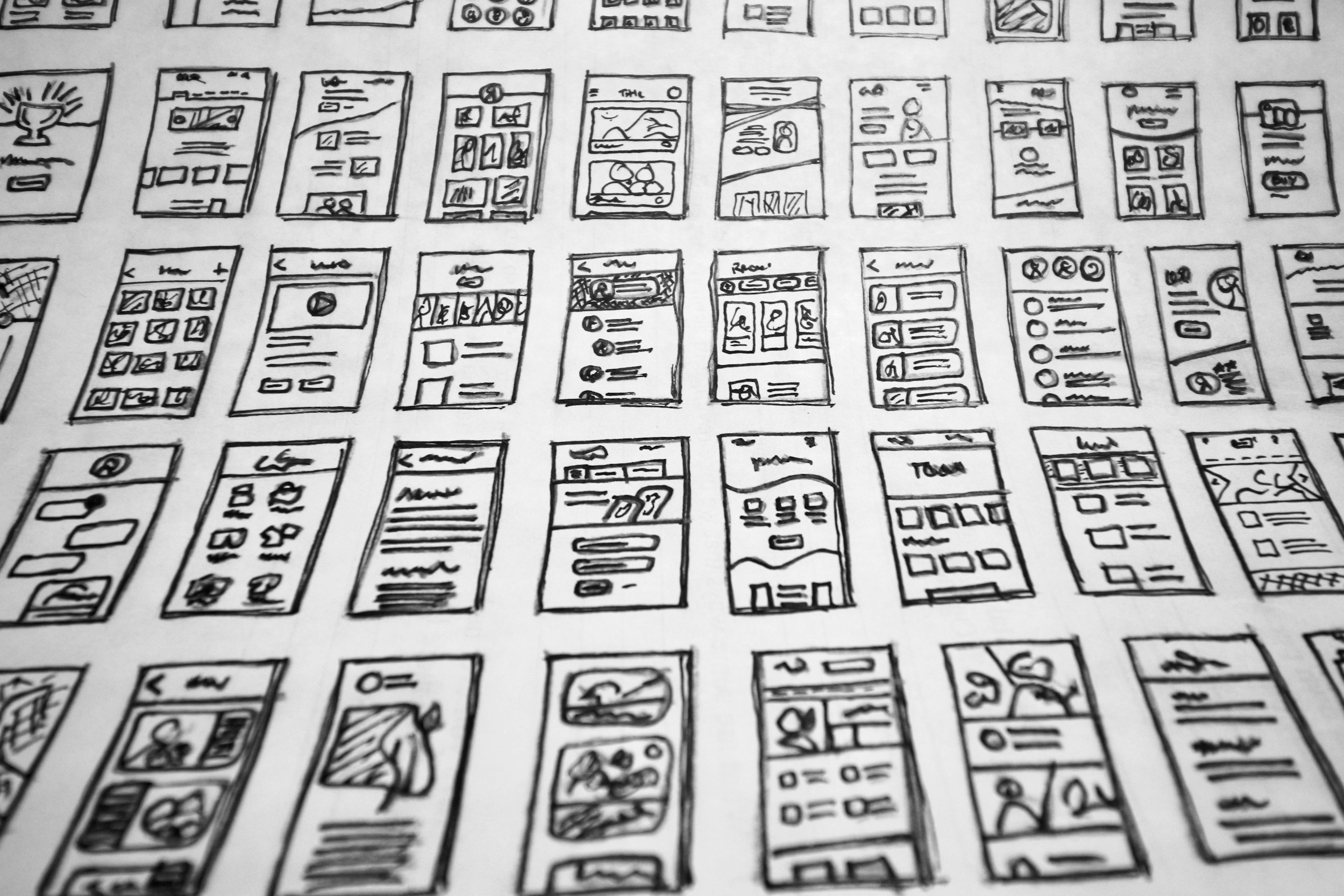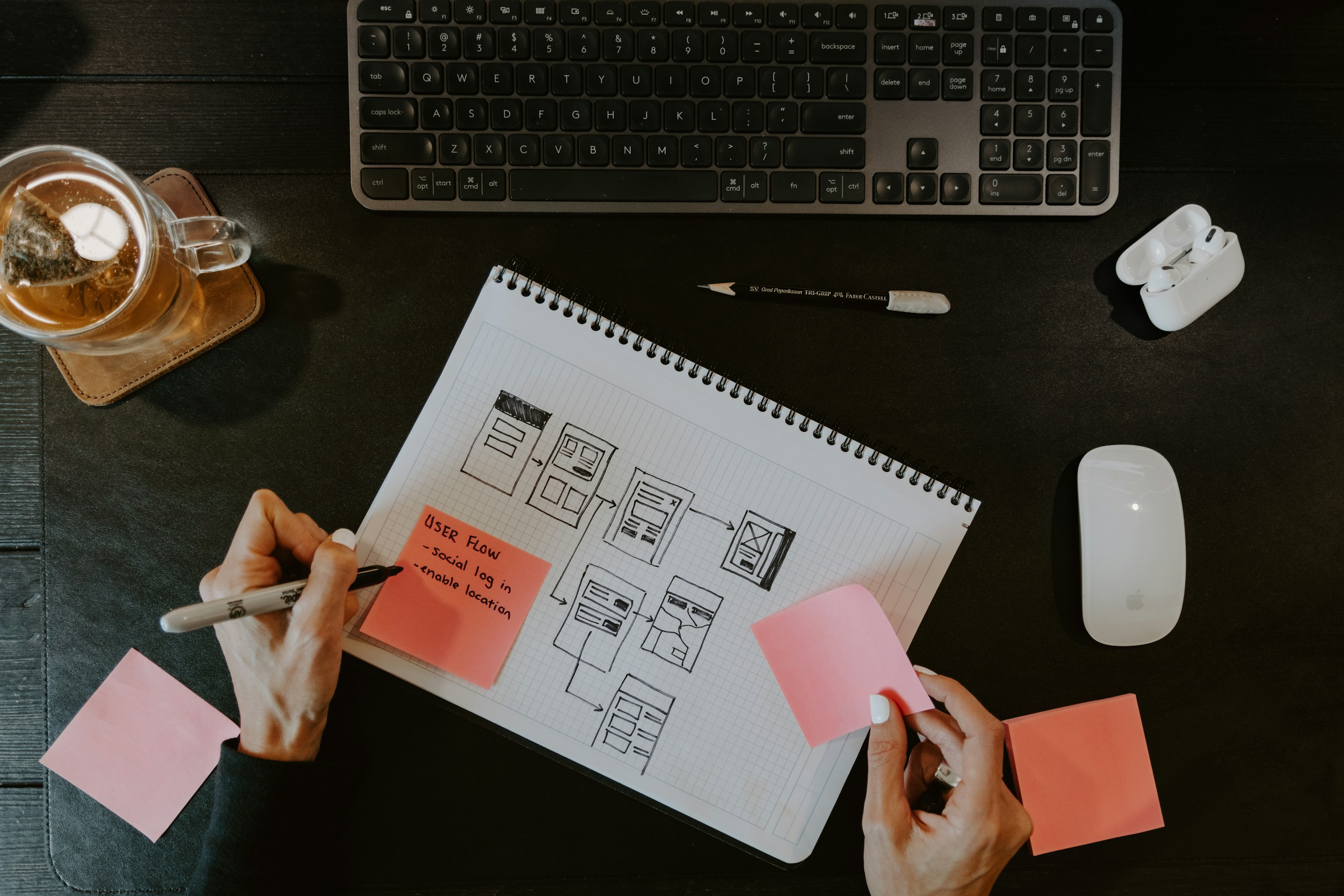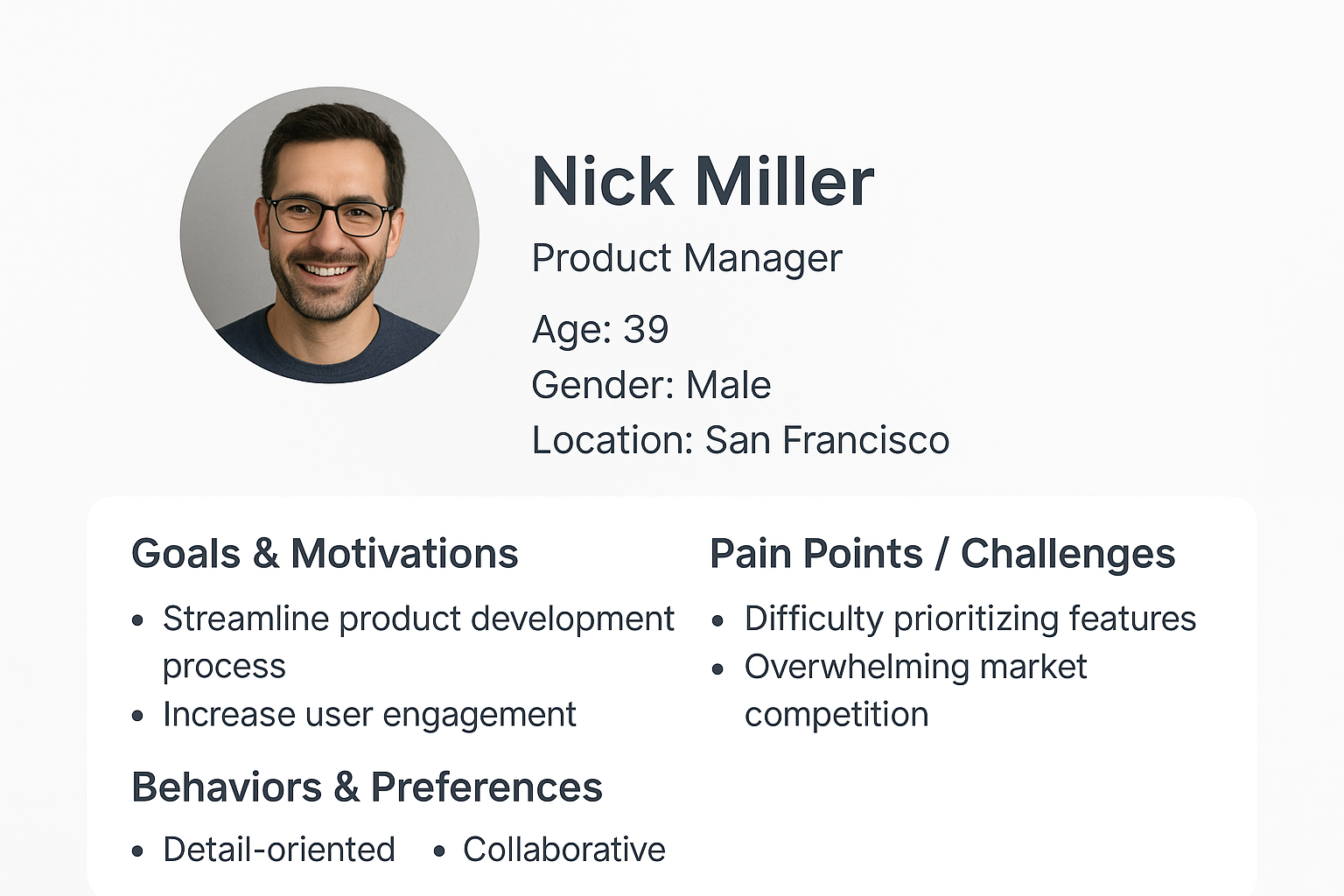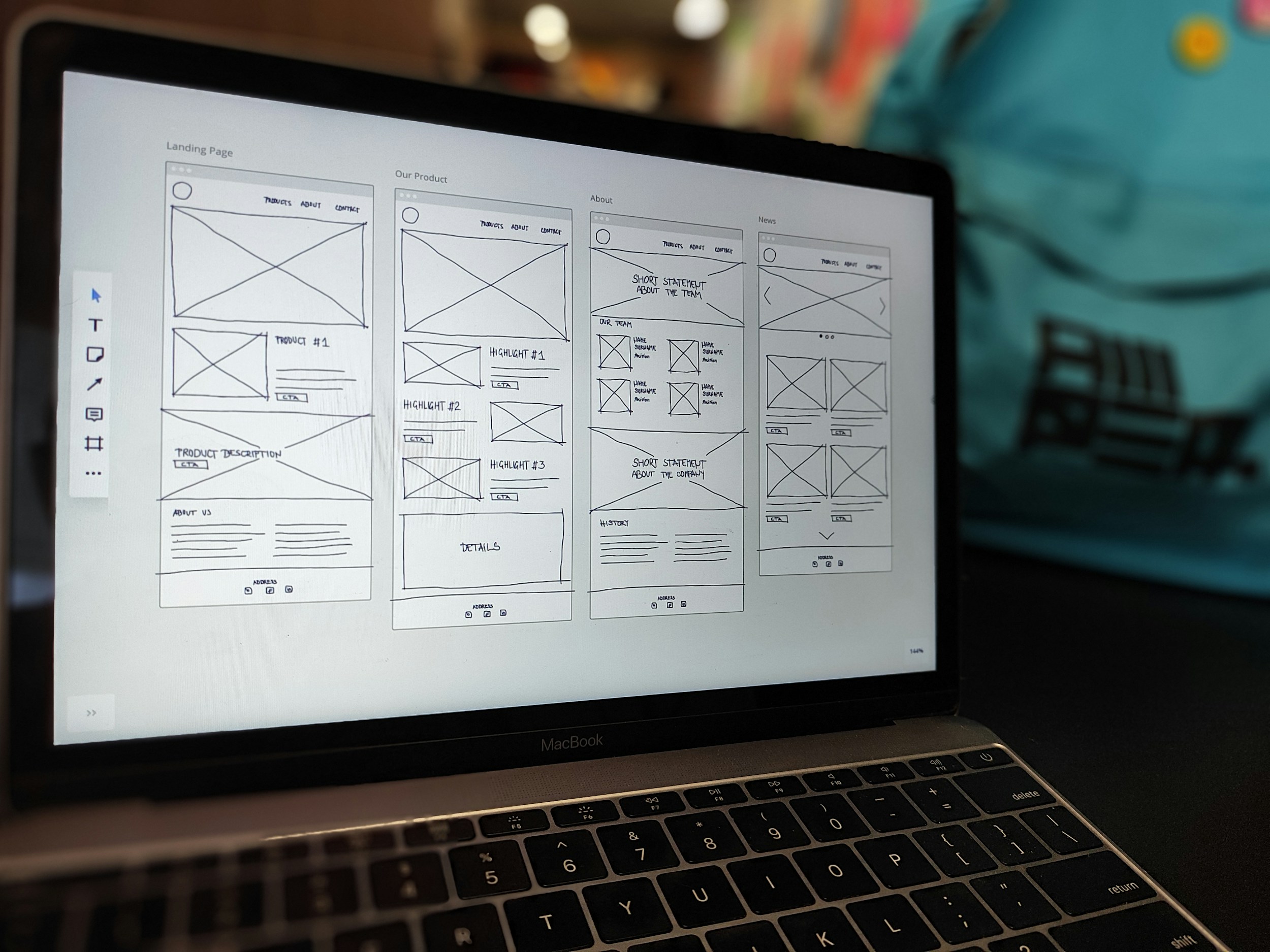harles
UX Process

Discovery Phase
When starting a UX or Product Design project, the journey begins with the discovery phase, a crucial stage focused on understanding the problem before jumping into solutions. During this phase, I gather insights through design thinking and research methods such as stakeholder interviews, workshops, and collaborative sessions. These help uncover user needs, business goals, and potential pain points. While having the user’s voice to guide the process is essential, I approach every project with empathy and an open mind, ensuring that I actively listen, challenge assumptions, and minimize personal biases to create solutions that truly resonate with users.
These are some clear, measurable, and actionable outcomes from my work as the primary designer for the Kuja Drivers mobile app:
- Design Thinking Workshops
- Stakeholder Interviews and briefing
- User Interviews
- Problem Framing Workshops
- Establishing Measurement Baselines
Planning
Planning is a collaborative effort that brings together product, design, engineering, accessibility, and business teams to align on goals and priorities. While planning can be challenging due to unknowns and dependencies, I focus on bringing clarity and finding a clear path forward while staying flexible and agile. I work closely with cross-functional partners to define roadmaps and create work-back schedules, ensuring we move efficiently, allow enough time for ideation and validation, and deliver solutions that meet both user needs and business objectives.
Discovery Phase
When starting a UX or Product Design project, the journey begins with the discovery phase which is a crucial stage focused on understanding the problem before jumping into solutions. During this phase, I gather insights through design thinking and research methods such as stakeholder interviews, workshops, and collaborative sessions. These help uncover user needs, business goals, and potential pain points. While having the user’s voice to guide the process is essential, I approach every project with empathy and an open mind, ensuring that I actively listen, challenge assumptions, and minimize personal biases to create solutions that truly resonate with users.

UX Flow
UX flows may not always look visually appealing, but they are a powerful communication tool. They map out the intended approach, user journey, and can even function as technical diagrams to align the entire team. By helping stakeholders and cross-functional partners visualize and understand the user’s path, UX flows ensure clarity and shared understanding. Whether through a formal UX flow or an informal whiteboarding session, I rely on these diagrams as a core part of defining and shaping new experiences.

Personas & Journey Mapping
“Who are we designing for?” Creating personas is a valuable step in ensuring that the user experience is shaped around the needs, behaviors, and goals of real users. To provide true value, personas are always grounded in research and real data, not assumptions. I use personas to help teams empathize with users and keep their perspectives at the center of decision-making. Throughout the design process, I often refer back to personas to validate ideas and ensure that every experience is crafted through the user’s lens.
Wire-framing
Wireframing and low-fidelity prototyping are essential steps in shaping the user experience without getting caught up in visual details like branding or UI polish. During this phase, I explore multiple solutions, iterating quickly until I find the right direction. I often run formal or informal design reviews with peers to gather feedback and strengthen my ideas.
The goal of my wireframes isn’t to make them visually perfect but to communicate intent, validate direction, and align the team before moving into high-fidelity design. I use a range of tools from pen and paper to MIRO, Figma, FigJam, and Sketch depending on the project needs. Whenever possible, I prototype my wireframes to better understand the holistic experience and test flows early, ensuring we make smarter decisions before investing time in final designs.
Wire-framing:
- Sketching
- White boarding
- Low-fi Prototyping

Ideation
There’s rarely a single perfect solution to any problem, which is why I embrace a highly explorative ideation process. At the start, I generate a wide range of ideas without judgment, giving my creativity room to run freely. From there, I refine and filter those ideas to ensure they align with the problem space, user needs, and project goals. Whenever possible, I continue iterating and exploring beyond the first viable solution, pushing to uncover better, smarter, and more impactful outcomes.
Prototyping
While there isn’t always time to build fully interactive prototypes, my coding background and experience with tools like Figma, UXPin, InVision, and Adobe XD allow me to communicate design intent effectively across multiple mediums. My understanding of development helps me collaborate seamlessly with engineers, ensuring the integrity of the user experience is maintained through implementation.
When time allows, I enjoy crafting high-fidelity prototypes that showcase the final experience, including detailed interaction design. I’m confident working across various prototyping tools and continuously push myself to learn new techniques to bring ideas to life more effectively.
Developer hand-off
UX and Developers often have to communicate and compromise on solutions based on various limitations. Because I have coding experience I have a strong empathy for developers. I understand what impacts their work and the challenges they face. I can also speak their language and have a deep understanding of web technologies. This means I can easily work with them to find solutions and clearly provide direction and feedback to help them successfully build the experience with accuracy. I am comfortable in tech grooming sessions working with developers to find ideal solutions and I’m flexible to technical constraints, open to feedback and creative ideas on how to solve complex problems.
Dev Hand-off:
- Design Specs
- Interaction Design Directions
Measure and iterate
I have extensive experience working with data and analytics from tools like A/B testing platforms, Google Analytics, and more. Leveraging both first-party and third-party data, I evaluate the performance and success of the experiences I design.
Working in high-performance environments, I’ve successfully driven record user sign-ups, increased sales, boosted donations, and improved customer satisfaction. I believe it’s essential to define success metrics early in the project, enabling us to measure impact accurately and exceed expectations through a data-informed, creative approach.
Measure:
- Google Analytics
- Heat Mapping
- A/B Testing
- Multi-Variate Testing
- Key Performance Indicators (KPIs)
- Revenue Tracking
harles
Copyright 2025 by Charles Nwafor
harles
UX Process

Discovery Phase
When starting a UX or Product Design project, the journey begins with the discovery phase, a crucial stage focused on understanding the problem before jumping into solutions. During this phase, I gather insights through design thinking and research methods such as stakeholder interviews, workshops, and collaborative sessions. These help uncover user needs, business goals, and potential pain points. While having the user’s voice to guide the process is essential, I approach every project with empathy and an open mind, ensuring that I actively listen, challenge assumptions, and minimize personal biases to create solutions that truly resonate with users.
These are some clear, measurable, and actionable outcomes from my work as the primary designer for the Kuja Drivers mobile app:
- Design Thinking Workshops
- Stakeholder Interviews and briefing
- User Interviews
- Problem Framing Workshops
- Establishing Measurement Baselines
Planning
Planning is a collaborative effort that brings together product, design, engineering, accessibility, and business teams to align on goals and priorities. While planning can be challenging due to unknowns and dependencies, I focus on bringing clarity and finding a clear path forward while staying flexible and agile. I work closely with cross-functional partners to define roadmaps and create work-back schedules, ensuring we move efficiently, allow enough time for ideation and validation, and deliver solutions that meet both user needs and business objectives.
Discovery Phase
When starting a UX or Product Design project, the journey begins with the discovery phase which is a crucial stage focused on understanding the problem before jumping into solutions. During this phase, I gather insights through design thinking and research methods such as stakeholder interviews, workshops, and collaborative sessions. These help uncover user needs, business goals, and potential pain points. While having the user’s voice to guide the process is essential, I approach every project with empathy and an open mind, ensuring that I actively listen, challenge assumptions, and minimize personal biases to create solutions that truly resonate with users.

UX Flow
UX flows may not always look visually appealing, but they are a powerful communication tool. They map out the intended approach, user journey, and can even function as technical diagrams to align the entire team. By helping stakeholders and cross-functional partners visualize and understand the user’s path, UX flows ensure clarity and shared understanding. Whether through a formal UX flow or an informal whiteboarding session, I rely on these diagrams as a core part of defining and shaping new experiences.

Personas & Journey Mapping
“Who are we designing for?” Creating personas is a valuable step in ensuring that the user experience is shaped around the needs, behaviors, and goals of real users. To provide true value, personas are always grounded in research and real data, not assumptions. I use personas to help teams empathize with users and keep their perspectives at the center of decision-making. Throughout the design process, I often refer back to personas to validate ideas and ensure that every experience is crafted through the user’s lens.
Wire-framing
Wireframing and low-fidelity prototyping are essential steps in shaping the user experience without getting caught up in visual details like branding or UI polish. During this phase, I explore multiple solutions, iterating quickly until I find the right direction. I often run formal or informal design reviews with peers to gather feedback and strengthen my ideas.
The goal of my wireframes isn’t to make them visually perfect but to communicate intent, validate direction, and align the team before moving into high-fidelity design. I use a range of tools from pen and paper to MIRO, Figma, FigJam, and Sketch depending on the project needs. Whenever possible, I prototype my wireframes to better understand the holistic experience and test flows early, ensuring we make smarter decisions before investing time in final designs.
Wire-framing:
- Sketching
- White boarding
- Low-fi Prototyping

Ideation
There’s rarely a single perfect solution to any problem, which is why I embrace a highly explorative ideation process. At the start, I generate a wide range of ideas without judgment, giving my creativity room to run freely. From there, I refine and filter those ideas to ensure they align with the problem space, user needs, and project goals. Whenever possible, I continue iterating and exploring beyond the first viable solution, pushing to uncover better, smarter, and more impactful outcomes.
Prototyping
While there isn’t always time to build fully interactive prototypes, my coding background and experience with tools like Figma, UXPin, InVision, and Adobe XD allow me to communicate design intent effectively across multiple mediums. My understanding of development helps me collaborate seamlessly with engineers, ensuring the integrity of the user experience is maintained through implementation.
When time allows, I enjoy crafting high-fidelity prototypes that showcase the final experience, including detailed interaction design. I’m confident working across various prototyping tools and continuously push myself to learn new techniques to bring ideas to life more effectively.
Developer hand-off
UX and Developers often have to communicate and compromise on solutions based on various limitations. Because I have coding experience I have a strong empathy for developers. I understand what impacts their work and the challenges they face. I can also speak their language and have a deep understanding of web technologies. This means I can easily work with them to find solutions and clearly provide direction and feedback to help them successfully build the experience with accuracy. I am comfortable in tech grooming sessions working with developers to find ideal solutions and I’m flexible to technical constraints, open to feedback and creative ideas on how to solve complex problems.
Dev Hand-off:
- Design Specs
- Interaction Design Directions
Measure and iterate
I have extensive experience working with data and analytics from tools like A/B testing platforms, Google Analytics, and more. Leveraging both first-party and third-party data, I evaluate the performance and success of the experiences I design.
Working in high-performance environments, I’ve successfully driven record user sign-ups, increased sales, boosted donations, and improved customer satisfaction. I believe it’s essential to define success metrics early in the project, enabling us to measure impact accurately and exceed expectations through a data-informed, creative approach.
Measure:
- Google Analytics
- Heat Mapping
- A/B Testing
- Multi-Variate Testing
- Key Performance Indicators (KPIs)
- Revenue Tracking
harles
Copyright 2025 by Charles Nwafor
harles
UX Process

Discovery Phase
When starting a UX or Product Design project, the journey begins with the discovery phase, a crucial stage focused on understanding the problem before jumping into solutions. During this phase, I gather insights through design thinking and research methods such as stakeholder interviews, workshops, and collaborative sessions. These help uncover user needs, business goals, and potential pain points. While having the user’s voice to guide the process is essential, I approach every project with empathy and an open mind, ensuring that I actively listen, challenge assumptions, and minimize personal biases to create solutions that truly resonate with users.
These are some clear, measurable, and actionable outcomes from my work as the primary designer for the Kuja Drivers mobile app:
- Design Thinking Workshops
- Stakeholder Interviews and briefing
- User Interviews
- Problem Framing Workshops
- Establishing Measurement Baselines
Planning
Planning is a collaborative effort that brings together product, design, engineering, accessibility, and business teams to align on goals and priorities. While planning can be challenging due to unknowns and dependencies, I focus on bringing clarity and finding a clear path forward while staying flexible and agile. I work closely with cross-functional partners to define roadmaps and create work-back schedules, ensuring we move efficiently, allow enough time for ideation and validation, and deliver solutions that meet both user needs and business objectives.
Discovery Phase
When starting a UX or Product Design project, the journey begins with the discovery phase which is a crucial stage focused on understanding the problem before jumping into solutions. During this phase, I gather insights through design thinking and research methods such as stakeholder interviews, workshops, and collaborative sessions. These help uncover user needs, business goals, and potential pain points. While having the user’s voice to guide the process is essential, I approach every project with empathy and an open mind, ensuring that I actively listen, challenge assumptions, and minimize personal biases to create solutions that truly resonate with users.

UX Flow
UX flows may not always look visually appealing, but they are a powerful communication tool. They map out the intended approach, user journey, and can even function as technical diagrams to align the entire team. By helping stakeholders and cross-functional partners visualize and understand the user’s path, UX flows ensure clarity and shared understanding. Whether through a formal UX flow or an informal whiteboarding session, I rely on these diagrams as a core part of defining and shaping new experiences.

Personas & Journey Mapping
“Who are we designing for?” Creating personas is a valuable step in ensuring that the user experience is shaped around the needs, behaviors, and goals of real users. To provide true value, personas are always grounded in research and real data, not assumptions. I use personas to help teams empathize with users and keep their perspectives at the center of decision-making. Throughout the design process, I often refer back to personas to validate ideas and ensure that every experience is crafted through the user’s lens.
Wire-framing
Wireframing and low-fidelity prototyping are essential steps in shaping the user experience without getting caught up in visual details like branding or UI polish. During this phase, I explore multiple solutions, iterating quickly until I find the right direction. I often run formal or informal design reviews with peers to gather feedback and strengthen my ideas.
The goal of my wireframes isn’t to make them visually perfect but to communicate intent, validate direction, and align the team before moving into high-fidelity design. I use a range of tools from pen and paper to MIRO, Figma, FigJam, and Sketch depending on the project needs. Whenever possible, I prototype my wireframes to better understand the holistic experience and test flows early, ensuring we make smarter decisions before investing time in final designs.
Wire-framing:
- Sketching
- White boarding
- Low-fi Prototyping

Ideation
There’s rarely a single perfect solution to any problem, which is why I embrace a highly explorative ideation process. At the start, I generate a wide range of ideas without judgment, giving my creativity room to run freely. From there, I refine and filter those ideas to ensure they align with the problem space, user needs, and project goals. Whenever possible, I continue iterating and exploring beyond the first viable solution, pushing to uncover better, smarter, and more impactful outcomes.
Prototyping
While there isn’t always time to build fully interactive prototypes, my coding background and experience with tools like Figma, UXPin, InVision, and Adobe XD allow me to communicate design intent effectively across multiple mediums. My understanding of development helps me collaborate seamlessly with engineers, ensuring the integrity of the user experience is maintained through implementation.
When time allows, I enjoy crafting high-fidelity prototypes that showcase the final experience, including detailed interaction design. I’m confident working across various prototyping tools and continuously push myself to learn new techniques to bring ideas to life more effectively.
Developer hand-off
UX and Developers often have to communicate and compromise on solutions based on various limitations. Because I have coding experience I have a strong empathy for developers. I understand what impacts their work and the challenges they face. I can also speak their language and have a deep understanding of web technologies. This means I can easily work with them to find solutions and clearly provide direction and feedback to help them successfully build the experience with accuracy. I am comfortable in tech grooming sessions working with developers to find ideal solutions and I’m flexible to technical constraints, open to feedback and creative ideas on how to solve complex problems.
Dev Hand-off:
- Design Specs
- Interaction Design Directions
Measure and iterate
I have extensive experience working with data and analytics from tools like A/B testing platforms, Google Analytics, and more. Leveraging both first-party and third-party data, I evaluate the performance and success of the experiences I design.
Working in high-performance environments, I’ve successfully driven record user sign-ups, increased sales, boosted donations, and improved customer satisfaction. I believe it’s essential to define success metrics early in the project, enabling us to measure impact accurately and exceed expectations through a data-informed, creative approach.
Measure:
- Google Analytics
- Heat Mapping
- A/B Testing
- Multi-Variate Testing
- Key Performance Indicators (KPIs)
- Revenue Tracking
harles
Copyright 2025 by Charles Nwafor